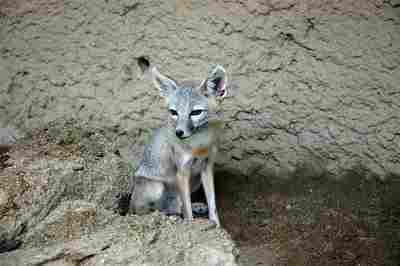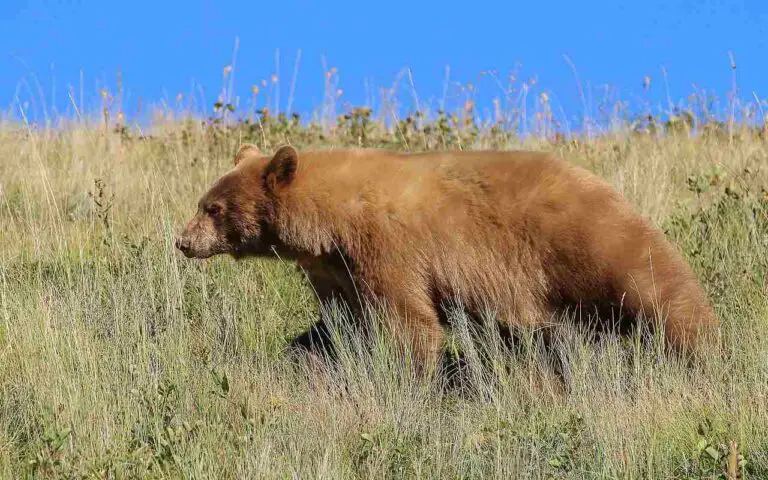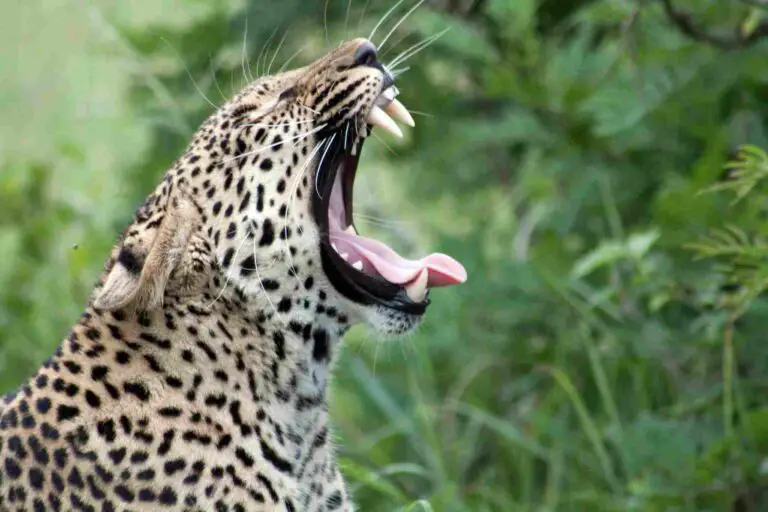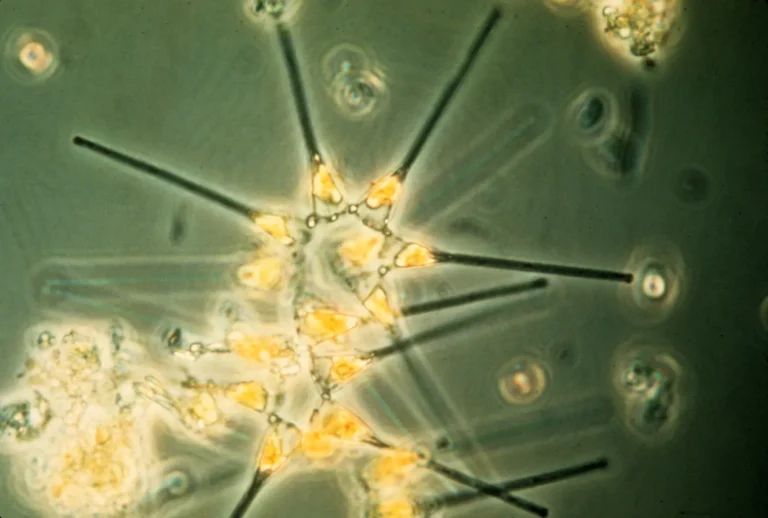Kit Fox Prey, Predators and Adaptations Discussed
Kit foxes eat rodents, birds, small reptiles, insects, carrion, and plant materials.
Animals that eat kit foxes are; coyotes, feral dogs, red and grey foxes, bobcats, and raptors.
Kit fox adaptations are; color camouflage, large ears for heat radiation, water use efficiency, keen sensitivity, and nocturnal behavior.
This article discusses what kit foxes eat, what eats kit foxes, as well as kit fox adaptations, as follows;
-What Do Kit Foxes Eat?
As omnivores, kit foxes eat rodents, small reptiles, birds, insects, carrion, and fruit.
1). Rodents as a Food Source for Kit Foxes
Kit foxes are highly skilled predators, that rely on a diet which is primarily composed of rodents.
Some examples of the rodents which kit foxes consume in their diet include; kangaroo rats, pocket mice, ground squirrels, and cottontail rabbits. Each of these is briefly discussed below;
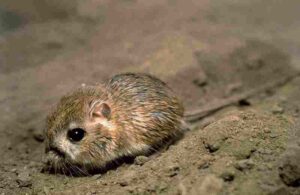
Kit foxes often hunt kangaroo rats, which are known for their powerful hind legs that enable them to make impressive leaps and move rapidly. These rodents are a common food source for kit foxes due to their relative abundance in desert ecosystems.
Pocket mice are another group of small, nocturnal rodents that live in burrows. They are often an important part of the kit fox diet and are often caught by the foxes during their nighttime foraging.
Kit foxes are also known to consume ground squirrels, which are diurnal rodents. These squirrels are active during the day, making them a potential food source for kit foxes during their own nocturnal hunting activities (because ground squirrels are less active and can be caught at night).
While rats and mice represent their primary food source, kit foxes may occasionally prey on other rodents such as cottontail rabbits, when the opportunity arises. Cottontail rabbits are larger than most rodents in arid and semiarid environments, and provide a more substantial meal.
These examples highlight the kit fox's adaptability in hunting a variety of prey species to meet their dietary needs. Kit foxes are also crucial in controlling rodent populations within the desert habitat, and thereby help to maintain the balance of these ecosystems.
2). Birds
As stated earlier, kit foxes are primarily carnivorous and often focus on consuming rodents as their main food source.
While they are opportunistic hunters, they are not typically specialized bird predators. Kit foxes do occasionally consume birds, but it is not a significant part of their diet. When they consume birds, it is more likely to be small, ground-dwelling species that can be captured through stalking and ambush techniques.
Examples of Birds that are Consumed by Kit Foxes
Examples of birds that kit foxes may consume include; quail, pheasants, and some ground-nesting birds. They are discussed individually as follows;
Kit foxes may opportunistically hunt quail, particularly species like Gambel's quail that are ground-dwelling and found in desert regions.
In some areas, kit foxes may consume pheasants, which are ground-dwelling birds that are often introduced for hunting purposes.
Kit foxes might target ground-nesting birds such as certain species of sparrows or larks, especially when they come across their nests while foraging.
It is important to reiterate that while kit foxes may occasionally prey on birds, it's not a common or substantial part of their diet. Their primary prey consists of rodents and other small mammals, which are more abundant and readily available in their desert habitats.
3). Small Reptiles as a Food Source for Kit Foxes
Kit foxes, being opportunistic predators, may include small reptiles in their diet, as these ate usually available in arid desert environments.
Some examples of small reptiles that kit foxes might consume include; whiptail lizards, geckos, desert skinks, and small snakes.
Various species of small lizards can be part of a kit fox's diet. This can include whiptail lizards, collared lizards, and spiny lizards, among others.
Geckos are nocturnal reptiles that are active at night, which makes them potential prey for kit foxes during their own nighttime predatory activities.
Desert skinks are another group of small, ground-dwelling lizards that kit foxes may consume if they come across them.
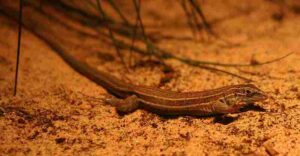
While not a major food source, kit foxes may occasionally prey on small snake species when the opportunity arises. This could include species such as gopher snakes or blind snakes.
As with other secondary food sources; while kit foxes may eat small reptiles, they mainly focus on rodents and small mammals as their primary dietary staples in desert ecosystems. Reptiles are more likely to be included in their diet when the preferred food sources are scarce.
4). Insects
Kit foxes are omnivorous and opportunistic in their feeding tendencies, which means they may consume a variety of foods, including insects, depending on the instantaneous conditions. However, insects are not a primary or reliable food source for kit foxes, and they generally play a minor role in their diet.
Here we discuss some examples of insects that kit foxes may consume.
Examples of Insects in the Diet of Kit Foxes
Some examples of insects that kit foxes consume are; beetles, grasshoppers, crickets, ants, termites, moths and butterflies. Below is a concise discussion of each of these examples;
Various species of beetles may serve as secondary food sources for kit foxes, including ground beetles and dung beetles, which are often found in their desert habitats.
Grasshoppers and crickets are also fairly common in arid environments, and kit foxes may catch and consume them, especially during periods when other prey is less available.
Ants are abundant insects that kit foxes can easily access in their foraging areas. While ants are not a major source of edible biomass, kit foxes may eat them when searching for food.
In some desert regions, termites can be a seasonal food source for kit foxes when termite colonies are active.
Lastly, kit foxes may occasionally consume moths and butterflies, particularly during their nocturnal foraging activities.
It must again be emphasized that insects are just one component of the kit fox diet, as these foxes mainly rely on small mammals, especially rodents, as their primary biomass and energy source. Insects are typically preyed upon when other food options are limited or during specific seasons when insects are highly abundant (or even invasive) in their habitat.
5). Carrion as a Food Source for Kit Foxes
As mentioned severally before, kit foxes are opportunistic feeders, and they do consume carrion, which simply refers to the remains of dead animals.
While they are primarily carnivorous and hunt live prey, they will scavenge carrion as a viable supplement, when it is available. The subsection below provides more information on kit foxes consuming carrion.
Overview of the Consumption of Carrion and Scavenging Tendencies of Kit Foxes
When discussing the consumption of carrion by kit foxes, some key themes and/or concepts that must be brought up include; scavenging behavior, carrion types, seasonal availability, carrion as a supplementary food source, ecologic implications, and effects on hunting pressure. These are collectively addressed as follows;
Kit foxes are known scavengers and will opportunistically exploit available carrion. This behavior enables them to take advantage of all accessible food resources and reduce the need for active hunting, while improving their ecologic resilience and the sustainability of the entire desert food chain.
Carrion that is consumed by kit foxes can include the remains of various animals, such as small mammals, birds, reptiles, and even larger organisms when the chance arises. This behavior helps prevent waste in the ecosystem, by serving as a form of natural recycling.
The availability of carrion can vary notably with the seasons and local conditions. Kit foxes are more likely to scavenge carrion when live prey is scarce, which could occur during periods of extreme weather/drought, or in times when animals die due to natural causes.
Carrion serves as a supplementary food source for kit foxes. While they primarily hunt rodents and other small mammals, carrion consumption can help them to survive when their primary prey is less available.
Kit foxes, by consuming carrion, are highly instrumental in recycling nutrients from organic matter back into the abiotic resource-pool of the desert ecosystem. Their scavenging behavior helps to break down the remains of dead animals, facilitating biodegradation and nutrient cycling.
As already mentioned earlier, by utilizing carrion, kit foxes can reduce the need for active hunting, which may have benefits during periods of resource scarcity or when live prey is harder to find.
The discussion so far implies that, kit foxes are adaptable predators that incorporate carrion into their diet when necessary. This scavenging behavior helps them to continuously meet their nutritional needs and ecological role(s) in their arid desert habitats.
6). Fruit (and Other Plant Materials)
Kit foxes are primarily carnivorous, so that they rely on a diet of small mammals, birds, insects, and other animal prey. However, as opportunistic feeders, they have also been observed consuming fruit, particularly in certain circumstances. This section addresses some key points regarding fruit and plant-matter consumption by kit foxes.
Kit Foxes as Consumers of Fruits and Plant Materials
Discussing the consumption of fruits and other forms of plant materials by kit foxes must include references to factors like; opportunistic behavior, seasonality of fruit availability, dietary supplementation, fruit scavenging, diversification, and nutrient accessibility. More details are provided as follows;
Kit foxes will consume fruit opportunistically when it is available, but fruit is not a primary or significant part of their diet.
Fruit consumption by kit foxes may increase in specific seasons when edible fruits are abundant, such as during late summer or early fall when desert plants like cacti produce fruit.
Fruit can provide kit foxes with dietary supplements, particularly in the form of hydration and essential vitamins. Fruits such as prickly pear cactus fruits are high in water content, which helps foxes to stay hydrated in arid desert environments.
It must be mentioned that kit foxes are more likely to consume fruit that has fallen to the ground or is easily accessible. They may not actively seek out fruit as they do with animal prey.
Consuming fruit can add dietary variety for kit foxes, and this variety may be particularly valuable when animal prey is less available.
While fruit is not their main food source, it can offer nutritional benefits to kit foxes, including carbohydrates and essential vitamins.
Kit foxes have a flexible diet that allows them to adapt to seasonal changes and varying prey availability. The consumption of fruit can help them balance their nutritional needs.
In general, while kit foxes are carnivorous by nature, they will consume fruit opportunistically when it is accessible and can provide them with nutritional benefits, especially in desert environments where the availability of water sources may be low. Their ability to incorporate fruit into their diet is a flexible survival strategy that helps them adapt to changing conditions.
-What Eats Kit Foxes
Animals that eat kit foxes are; coyotes, feral dogs, red and grey foxes, bobcats, and raptors.
1). Coyotes as Predators of Kit Foxes
Coyotes are opportunistic predators that may prey on kit foxes under certain circumstances. Below is a discussion of some key points about coyotes' predation on kit foxes.
Key Aspects of Coyotes' Predation on Kit Foxes
Concepts linked to the consumption of kit foxes by coyotes include; competitive relationship, size and strength differences, higher risk for juveniles, fox carcass scavenging, behavioral avoidance, human influence, and impact(s) on kit fox populations. Below is further elaboration of these concepts;
Coyotes and kit foxes share similar ecological niches and are often in direct competition for food and resources. This direct competition can lead to predation by coyotes on kit foxes, particularly when resources are scarce.
Generally, coyotes are larger and stronger than kit foxes, which can give them an advantage in confrontations. This size difference can make kit foxes vulnerable to predation by coyotes.
Juvenile kit foxes, in particular, are more vulnerable to predation by coyotes. Coyotes may prey on kit fox pups if they encounter them within or near their dens.
Coyotes may also scavenge on the remains of deceased kit foxes. When kit foxes die due to natural causes, predation, or other factors; their carcasses can become a potential food source for scavenging coyotes.
Kit foxes have developed behavioral strategies to reduce the risk of predation by coyotes and other animals. These strategies include avoiding areas where coyote activity is high, especially when they have pups to protect.
Human-induced changes to the environment, such as habitat fragmentation and urbanization, can increase interactions between coyotes and kit foxes, potentially leading to increased predation.
The extent of coyote predation on kit fox populations can vary depending on ecological factors, prey availability, and human activities. In some areas, it can have a significant impact on kit fox population dynamics.
It is important to note that while coyotes may pose a threat to kit foxes, predation is just one of many challenges that kit foxes face in their natural habitats. Conservation efforts often focus on managing and preserving these habitats to support the survival of kit fox populations and other wildlife species.
From issues raised so far, it can be deduced that the most important aspects of coyote predation on kit foxes include;
Competition for Resources
Vulnerability of Juveniles
Scavenging Behavior
Avoidance Strategies
Human Impact
Conservation Efforts
2). Feral Dogs
Feral dogs represent another group of potential predators for the kit fox.
The most important issues to be discussed with respect to feral dog predation on kit foxes include; vulnerability of kit foxes, direct predation, human influence, conservation concerns, and mitigation strategies.
Feral dogs pose a significant threat to kit foxes, especially pups, due to their larger size and predatory behavior. These dogs may actively hunt and prey on kit foxes, thereby impacting kit fox populations.
In most cases, the presence of feral dogs in kit fox habitats occurs as a result of human abandonment or neglect. Their competitive impact, and predation on kit foxes can therefore be exacerbated by human influences.
Feral dog predation is a conservation concern, and efforts usually focus on managing feral dog populations and protecting kit fox habitats.
Here, conservationists work to reduce feral dog predation by implementing measures such as responsible pet ownership and targeted control of feral dog populations.
3). Red and Grey Foxes
The most important aspects of red and grey foxes' predation on kit foxes include concepts and phenomena like; intraspecific dynamics, avoidance behavior, dietary flexibility, predatory impact, and conservation considerations. These potential predators are distinctive for their close biological relationship to kit foxes.
As fellow canids, red and grey foxes are potential intraspecific predators of kit foxes, particularly when they compete for the same resources.
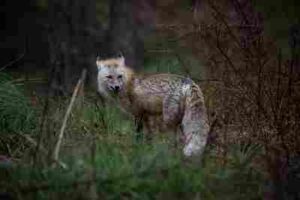
Kit foxes may exhibit avoidance behavior to minimize encounters with red and grey foxes, reducing the risk of predation.
Red and grey foxes have a varied diet and may consume small mammals like kit foxes, especially when other food sources are scarce.
The impact of red and grey fox predation on kit fox populations varies with local conditions, prey availability, and ecological factors.
Conservation efforts focus on habitat preservation and management to mitigate the effects of predation and ensure kit fox population viability.
4). Bobcats
Bobcats are feline carnivores whose ecologic niche generally overlaps with that of kit foxes, compared to whom they are better equipped in size and strength as predator.
Bobcats' predation on kit foxes can be discussed within various contexts such as predation risk, competition for resources; conservation efforts, and predatory impact. The outline below elaborate this;
Bobcats are known predators of kit foxes, particularly targeting juveniles and vulnerable (sick, injured, malnourished) adult kit foxes.
Bobcats and kit foxes compete for similar food sources and territories, often leading to predation events.
Bobcat predation can influence kit fox population dynamics, especially in areas with a high density of both species.
Conservation strategies aim to preserve kit fox habitats and manage interactions between kit foxes and bobcats in order to support kit fox populations.
5). Raptors
Raptors, such as hawks and eagles, are not major predators of kit foxes.
Kit foxes are primarily terrestrial and do not form a substantial part of raptors' diets.
However, there may be rare instances of raptors preying on kit foxes even though it is not a notable aspect of their predation behavior. Kit foxes are more at risk from ground-based predators, such as coyotes and bobcats.
-Kit Fox Adaptations
Some prominent adaptations of kit foxes are; color camouflage, large ears for heat radiation, water use efficiency, keen sensitivity, and nocturnal behavior.
1). Color Camouflage: One of the Kit Fox Adaptations
Color camouflage adaptation in kit foxes helps them blend into their arid desert environments, and reduces their visibility to predators and prey.
Their pale, sandy-colored fur matches the desert sand, providing effective camouflage during daytime and nighttime hunts.
This adaptation aids in both hunting and avoiding predation, and makes them better suited to survive in their natural habitat.
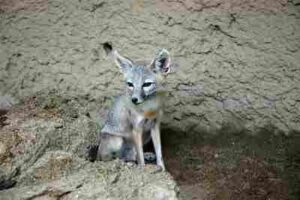
2). Large Ears for Heat Radiation
Large ears in kit foxes serve as an adaptation for heat radiation in their arid desert habitats. The ears have a high density of blood vessels, and they can help kit foxes to regulate their body temperature in various ways; which can be discussed within different contexts and using terms like heat dissipation, thermoregulation, behavioral cooling, and nighttime insulation.
The large surface area of the ears allows for efficient dissipation of excess thermal energy in the arid environment. Blood vessels close to the skin's surface release such heat as warm blood circulates through the ears, thereby helping cool the fox down.
Kit foxes can dissipate excess body heat through their ears, especially during hot desert days, preventing overheating and maintaining a stable body temperature.
When the weather is extremely hot, kit foxes may also use panting to expel their body heat. Blood flow to the ears enhances this cooling process.
In cold desert nights, kit foxes can minimize heat loss through their ears by constricting blood vessels, helping them retain warmth.
Generally, the large ears of kit foxes are an important adaptation that aids in thermoregulation, and helps them thrive in the challenging desert environment by efficiently managing their body temperature.
3). Water Use Efficiency: One of the Kit Fox Adaptations
Water use efficiency is a critical adaptation in kit foxes, and is of particular necessity in their drought-prone habitats. This adaptation helps kit foxes to cope with limited water availability and reduce their dependence on external water sources. Here we discuss how water use efficiency plays a role in the survival of kit foxes.
Role of Water Use Efficiency in Kit Fox Survival
When discussing the efficiency of water consumption and the tendency of effective water conservation, in kit foxes, issues which are usually raised revolve around; dietary water sources, conserving metabolic water, nocturnal behavior, burrow dwelling, kidney specialization, reduced water dependency, and diverse behavioral adaptations.
Kit foxes obtain a significant portion of their water needs from the prey which they consume. Small mammals, insects, and other sources of food have a certain amount of water content in their bodies, which helps to supplement the foxes' hydration.
Considerable efficiency at conserving metabolic water can be attributed to kit foxes. This water is produced during the breakdown of food in their bodies. They minimize water loss through respiration and other metabolic processes.
Kit foxes are mainly nocturnal, which reduces their exposure to daytime heat and aids them in conserving water. By staying active during cooler nighttime hours, they can limit their water loss due to evaporation through respiration and sweating.
Also, kit foxes often dwell in burrows, which provide a more stable microenvironment with lower temperatures and higher humidity than the exposed desert landscape. This minimizes the foxes' need for active cooling and reduces water loss.
Kit foxes have specialized kidneys that are generally efficient at conserving water by producing concentrated urine. This helps them to excrete less water and retain as much fluid as possible.
Based on such physiological characteristics, it is obvious that kit foxes have evolved to thrive in areas with limited access to surface water. They can go for extended periods without needing to drink water from external sources.
In times of water scarcity, kit foxes may also reduce their activity levels and conserve energy to further minimize water expenditure.
Generally, these water use efficiency adaptations allow kit foxes to inhabit arid desert environments successfully. They have evolved to maximize their water resources, relying on both dietary and metabolic sources, which helps them to survive in regions where water is a precious commodity.
4). Keen Sensitivity
Keen sensitivity is another notable adaptation in kit foxes, and enhances their ability to survive and thrive in their desert habitats, as well as the effectiveness of their contribution to the sustenance of the desert food web.
This adaptation involves heightened senses, which can be particularly analyzed in areas like hunting, hearing, smell, thermoregulation, predator avoidance, navigation of harsh environments, and communication. The subsection below discusses them summarily.
Aspects and Applications of Sensitivity in Kit Foxes
Kit foxes have excellent vision, including the ability to see well in low-light conditions. This adaptation is particularly important for their nocturnal hunting behavior. Their keen eyesight allows them to detect prey and navigate their surroundings in the dark.
Kit foxes possess acute hearing, which is essential for detecting the sounds made by potential prey, such as the rustling of small mammals or the movement of insects. This heightened sense of hearing aids in successful hunting.
Their keen sense of smell helps kit foxes locate prey, especially when the prey is hidden underground or in burrows. They can detect the scent of their quarry and use their digging prowess to unearth it.
Kit foxes can detect changes in temperature and respond accordingly. They are highly attuned to temperature variations, allowing them to conserve energy by minimizing physical activity during extremely hot or cold periods.
Their heightened senses is also instrumental in detecting potential predators. Keen vision, hearing, and smell enable them to be vigilant and evade threats from larger carnivores like coyotes, feral dogs and bobcats.
In their arid or semiarid habitats, kit foxes must navigate challenging terrain. Their heightened senses aid in locating food and water sources, finding shelter, and identifying pathways through the landscape.
Lastly, kit foxes use vocalizations and body language to communicate with one another, and their heightened senses assist in interpreting these signals.
The keen sensitivity of kit foxes allows them to be highly adapted to their desert environment. Their enhanced sensory perception helps them locate prey, avoid predators, and efficiently navigate their surroundings, contributing to their survival in challenging and often harsh conditions.
5). Nocturnal Behavior: One of the Kit Fox Adaptations
Nocturnal behavior is a useful adaptation in kit foxes, especially in their hot desert environment. This adaptation entails being primarily active during the night and sleeping during the day. The role of nocturnal behavior in kit foxes is as discussed below.
Role of Nocturnal Behavior in Kit Foxes
Some functions, features and capabilities that can be linked to nocturnal behavior in kit foxes include; thermoregulation, water conservation, hunting success, predator avoidance, social interaction, and energy efficiency.
Desert environments can experience extreme temperature fluctuations, with scorching daytime heat and cool to frigid nighttime conditions. By being nocturnal, kit foxes can avoid the intense daytime heat, which helps them to conserve water and reduce the risk of overheating. They are active when the desert is cooler, making it easier for them to regulate their body temperature.
Water is a highly valuable resource in arid regions, and avoiding daytime activity helps kit foxes minimize its loss through evaporation. By foraging and being active at night, they can rely on metabolic water produced during digestion and reduce both their water demand and reliance on external water sources.
Kit foxes have adapted to nocturnal hunting. Their excellent night vision enables them to see in low-light conditions, giving them an advantage when hunting for nocturnal prey, such as small mammals and insects. This adaptation enhances their chances of accessing food resources.
Nocturnal behavior also aids in predator avoidance. Kit foxes share their habitat with larger carnivores like coyotes, which are mostly diurnal. By being active at night, kit foxes reduce the risk of encounters with such potential predators.
Kit foxes are social animals and often engage in group activities. Nocturnal behavior enables them to socialize, communicate, and coordinate activities with their family groups during the cooler nighttime hours.
Lastly, nocturnal behavior helps kit foxes to conserve energy during the day, and reduces the need for physical activity when temperatures are at their highest.
The role of nocturnal behavior in kit foxes is very instrumental to their survival in arid environments. It helps them regulate body temperature, conserve water, improve hunting success, avoid predators, engage in social interactions, and optimize energy consumption. This behavioral adaptation is a key contributor to their ability to thrive in challenging desert conditions.
*Additional Notes and Reiterations on Kit Fox Adaptations
Kit foxes (Vulpes macrotis) are highly adapted to arid desert environments in North America, and their survival in these harsh habitats is facilitated by a range of physiological, behavioral, and anatomical adaptations. Some key adaptations of kit foxes are; nocturnal behavior, large ears for heat regulation, water use efficiency, digging and burrowing, specialized diet, communication, keen senses and high ecological resilience.
1. Kit foxes are primarily nocturnal, which means they are most active during the night. This behavior helps them avoid the intense daytime heat in desert environments and minimizes water loss through evaporation.
2. Kit foxes have large, thin ears that serve as efficient radiators of excess body heat. These ears are rich in blood vessels, allowing them to release heat and aid in temperature regulation.
3. Kit foxes are adapted to survive with limited access to water. They can obtain moisture from their prey, minimize water loss through metabolic processes, and efficiently excrete concentrated urine.
4. Kit foxes are skilled diggers and often create burrows as shelter. These burrows help them stay cool during the day and provide protection from predators and extreme weather conditions.
5. Their diet consists primarily of small mammals, insects, and occasionally plants. This adaptation allows them to obtain water from their prey and adapt to the availability of food sources in arid environments.
6. Kit foxes use vocalizations, body language, and scent marking to communicate with one another. This social behavior helps them maintain family groups and avoid conflicts.
7. Their sandy-colored fur acts as effective camouflage in desert landscapes, helping them blend in with their surroundings and avoid predators.
8. Kit foxes have heightened senses, including excellent night vision, acute hearing, and a keen sense of smell. These senses are essential for hunting, detecting prey, and avoiding predators.
9. Kit foxes have a high reproductive rate, enabling them to quickly rebound from population declines. They can adapt to changes in prey availability and environmental conditions.
Kit foxes are considered a near-threatened species due to factors like habitat loss and human activities. Conservation efforts aim to protect their natural habitats and ensure their survival.
These adaptations collectively enable kit foxes to thrive in some of the most challenging environments on the continent, showcasing their remarkable resilience and ability to coexist with other desert-adapted wildlife.
Conclusion
Kit foxes eat animals like;
1. Rodents
2. Birds
3. Small Reptiles
4. Insects
5. Carrion
6. Fruit
Animals that may consume kit foxes include;
1. Coyotes
2. Feral Dogs
3. Red and Grey Foxes
4. Bobcats
5. Raptors
Kit fox adaptations are;
1. Color Camouflage
2. Large Ears for Heat Radiation
3. Water Use Efficiency
4. Keen Sensitivity
5. Nocturnal Behavior
